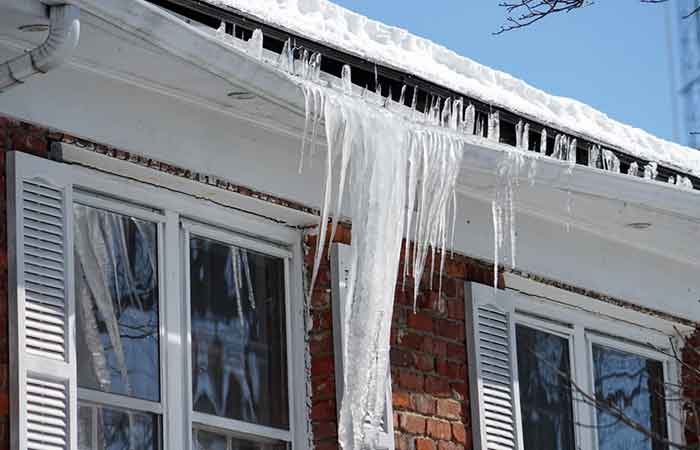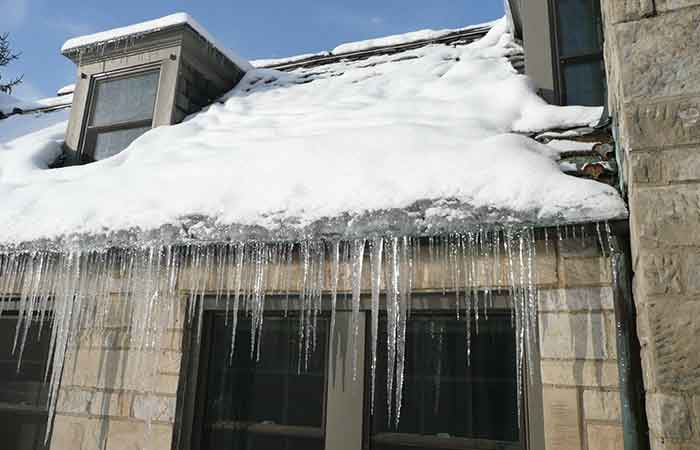During the winter, ice dams are one of the most destructive effects of having snow and ice on the roof. Ice dams form when heat from inside the house melts the snow on the roof into water. As the water flows towards the overhang of the roof, it’s cooled into ice since the outer parts of the roof are colder.
Ice dams can be caused by gutters only when the gutters are positioned poorly or clogged. However, given that ice dams form on the overhangs of roofs close to the gutters, it’s easy to associate and even blame the gutters for the dams. In most cases, the formation of ice dams is often unrelated to the position of gutters. This is because you’ll still find ice dams on houses without gutters.
Gutters and Ice dam Formation
Gutters are meant to transport the water from the roof to the downspout and away from the building in general. In normal circumstances, when the gutters get clogged, the water will overflow and pour on the sides of the gutter.
When it’s in the winter, clogged gutters hold up the water and, given that it’s cold outside, the water turns into ice. As more water from the roof flows down and reaches the gutter, it’ll continue turning into ice. With time, the ice builds up and forms an ice dam.
Given that ice dams also form even when the house has no gutter, clogged or poorly positioned gutters can worsen the ice dam.
When positioned poorly such that ice and snow doesn’t fall off the roof, gutters will lead to a buildup of ice and snow leading to the ice dam. If clogged, the gutters won’t transport the melted ice and will provide an easy location for the ice dam to form.
An ice dam which may form a certain amount of ice before falling off under its own weight will grow larger as the gutter will hold it in place.
Sagging gutters also make it easy for ice dams to form and grow as they retain water in some areas. They also support the weight of the ice thus making it easy for the ice dam to grow larger and weightier. Sagging gutters are also likely to be clogged hence likely to hold water for the ice dams to turn to ice.

In summary, gutters cause or contribute to the formation and growth of ice dams when they’re clogged, poorly positioned or sagging.
Effects of ice dams on roofs
Ice dams can have icicles which look beautiful although they can wreak serious havoc on your roof. Some of the problems caused by ice dams on the house include the following:
Break the gutters, roof, fascia boards, fasteners and downspouts
The weight of ice dams can grow so much that it’s enough to break down the roof and all the connected pieces. In most cases, the dam weakens these structures by seeping water under the shingles before breaking them down.
Rot the roof away
Between the lower edge of the ice dam and the snow on the upper sides of the roof there is a pool of water. As long as the ice dam remains intact, this pool of water will also be there. This water often starts leaking into the attic and the wall. With time, the ceiling board will start rotting and so will parts of the wall and roof such as the insulators.
Destroy the paint on the house
When the water from the ice dam seeps into the ceiling, it will slowly flow down the wall and onto the paint. As the water wets the wall, moisture is trapped under the paint. As the winter ends and the air warms, the moisture from the wall will try escaping and cause the paint to blister and peel off.
For these reasons, you need to prevent and get rid of ice dams before they damage your house. To prevent and eliminate them, you will need to know what causes them in the first place
Since ice dams are affected by gutters when they’re clogged, poorly positioned or sagging, you can remedy these issues as follows:
1. Unclog the gutters
Unclogging gutters depends on the location of the clog. Often, it’s in the downspout, corner or where two or more sections meet. If the clog is in the downspout, you will need to either tap the side of the downspout downwards, use an auger, push down the clog with a piece of cloth and water, or use a power tool like a vacuum to clear out the clog.
If the clog is in the joints between sections of the gutter or the corners of the house, you only need to scoop or pool out the clog to clear it away. The methods for clearing out the rest of the ice dam will help you reach the clog.
Once the clog is out, you can use other methods to melt the ice dam off the roof.
2. Refit the gutters correctly
If the gutters are too high up that ice from the roof gets impeded instead of falling off, it’s much easier for it to form an ice dam. Also, gutters that curve too much towards the roof encourage the formation of ice dams as they provide more support for the falling ice and the ice dam itself.
3. Repair or replace sagging gutters
Sagging gutters can be a headache as they not only give the house a bad look, but they also make it easier for ice dams to form on them. Sagging gutters easily get clogged and they are also likely to jut upwards for the ice dam to form on.
To remedy this issue, simply replace the gutter or, if it’s still in good condition, just repair it.
Make sure the gutters are at the right position when solving these issues. You need to know that gutters on their own won’t cause ice dams since ice dams will form on the roof whether you have gutters on the roof or not. With ice dams, the steeper the roof is, the less the likelihood of their formation.

More other ideas and tips get rid of ice dams in general include;
Break up the ice
You can break up the ice dam using a mallet or other light and blunt object to prevent damaging the shingles or other roofing materials. This type of work should be left to an expert as it’s quite delicate and dangerous given that you have to climb up a ladder in wet conditions.
Use an ice melter
An ice melter such as calcium chloride can be sprayed or sprinkled onto the ice to melt it away. You should sprinkle it across the face of the roof such that the melter thaws the front part of the ice dam to allow the rest of the dam to flow downwards.
Avoid using common salt or rock salt since they can damage metals, paint and the plants under the roof.
Clear gutters
Gutters and their downspouts should be cleared out with the ice and any clogs being removed to allow the water from the ice to flow away. As stated above, always aim to have clean gutters that are positioned correctly to prevent aiding the ice dam in its formation.
Keep snow off your roof
You can remove the snow off your roof with methods such as a rake or a shovel as deemed fit. This keeps the snow from building up and forming an ice dam in the first place. Be careful when carrying out this task as it’s full of risks. Avoid going on to the roof when it’s wet as you might fall off it.
Use a metal roof instead of shingles or tiles
Metal is a better heat conductor. As such, when the heat from the house reaches it, it’ll almost be uniformly warm and will thus melt any forming ice. This effectively keeps the ice dam away as it’ll simply slide off the roof.
If you can’t do that, install a metal strip on the lower side of the roof to melt off the ice when it starts forming.
Insulate the ceiling
You can insulate the upper parts of your living space to keep the heat from going into the attic and melting the snow to form an ice dam.
Vent the roof
To further keep the heat from the attic, you can install a vent to the outside of the roof. This way, the roof will always have a constant temperature to prevent the melting of ice.
As long as the snow on the roof isn’t melted into water, no ice will form and no ice dam will thus be there.
More on Gutters
- Why are Gutters Important & When are Gutters not Necessary?
- How Long do Gutters Last?
- How to Fix a Sagging Gutter
- How to Install Gutters Without Fascia Board
- Vinyl vs Aluminum vs Steel Gutters: Differences, Pros & Cons
- Rain Gutter Alternatives, Low Maintenance, Cheap & DIY Options
- Rain Diverter vs Gutter-Differences & Similarities
As an Amazon Associate, we earn from qualifying purchases. Details here
